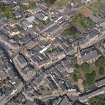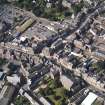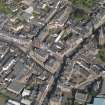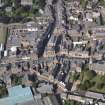Forfar, East High Street, Forfar Parish Church
Church (13th Century)
Site Name Forfar, East High Street, Forfar Parish Church
Classification Church (13th Century)
Alternative Name(s) Pre-reformation Church; Church Of Scotland; Old Parish Church; Parish Church Of Forfar
Canmore ID 33762
Site Number NO45SE 18
NGR NO 45722 50612
Datum OSGB36 - NGR
Permalink http://canmore.org.uk/site/33762
- Council Angus
- Parish Forfar
- Former Region Tayside
- Former District Angus
- Former County Angus
NO45SE 18.00 45722 50612
(NO 4572 5061) Ch (NAT)
OS 6" map, (1975)
NO45SE 18.01 Centred NO 45716 50592 Churchyard
NMRS REFERENCE
Architect: Samuel Bell 1791 (Steeple by Patrick Brown 1814 - attributed)
Tower inscribed "founded 1813 finished 1814 Patrick Brown, architect."
(Undated) information in NMRS.
The Church or Chapel of Forfar was founded in 1241 and dedicated to St James the Great. 'It has been surmised that the cruciform structure which occupied the site of the present parish church (built 1791) may have been identical with the medieval erection.'
A Reid 1902.
Parish Church of Forfar [NAT]
OS (GIS) MasterMap, June 2010.
Publication Account (1981)
Until after the Reformation the parishes of Restenneth and Forfar were combined. Restenneth's origins are ancient. The Pictish King Nectan is alleged to have founded a church there dedicated to St. Peter. David I founded an Augustinian Priory on the site. It was granted to Jedburgh in 1159 x 1163 and was in decline at the period of the Wars of Independence (Adamson, 1960, 18). A chapel at Forfar adjacent to Restenneth was dedicated by Bishop David de Bernham of St. Andrews in 1241, but the church at the priory functioned as the parish church until 1591(Reid,1902, 128; Warden, 1882, iii, 284). In that year, an arrangement was made whereby a church was built in the centre of the town of Forfar, but the name Restenneth was not dropped from the parish until 1652 when the town council purchased from Sir George Fletcher of Restenneth the patronage and tithes of the church. By the mid-eighteenth century, the fabric of the church in Forfar was said to be ruinous and a new church was erected substantially on the site of the old one by January 1791.
Information from ‘Historic Forfar: The Archaeological Implications of Development’ (1981).
Publication Account (2000)
The parish church was central to the community. A chapel dedicated to St James the Great, in 1241, by the Bishop of St Andrews, David de Bernham, probably stood on the site of the present church. It was attached to the Augustinian priory at Restenneth, the church of which functioned as Forfar's parish church throughout the middle ages figure 6. In about 1568, a new church was built on the site of this medieval chapel of St James, probably partially replacing it. By May 1586, Forfar and Restenneth were documented as separate parishes; this suggests that there was an intention to make them distinct. In 1591, it was agreed that the church at Forfar should replace that at Restenneth as the parish church of Forfar. The name Restenneth, however, was not dropped from the parish name until 1652, when the town council purchased from Sir George Fletcher of Restenneth the patronage and tithes of the church of Forfar. At some time, probably in the late 1650s, the Strang brothers, or probably more correctly, one surviving brother, who had prospered in Stockholm, despatched a fine bell for the church steeple to their home town.
A new plain gothic parish church was built in 1791, to a design of Samuel Bell; and when it was endowed with a new ashlar classic west spire, in 1813- 14, some of the stones of which, according to local tradition, came from the ruins of the old castle, 'Lang Strang', the bell shipped from Stockholm in the seventeenth century, was given pride of place in the new steeple. Alterations were made in 1836; and it underwent further remodelling and improvements in the 1880s; but much of the present structure reflects the eighteenth century church.
It appears that the sixteenth-century church had, in fact, incorporated part of the earlier thirteenth-century chapel into its fabric, but whether any of this composite structure survived the building of the eighteenth-century church is not clear. It is possible that the remains of earlier phases of the church may survive preserved beneath the present floor levels, or that earlier walls were reused as foundations, and these may be exposed during refurbishments or the insertion of new services.
Information from ‘Historic Forfar: The Archaeological Implications of Development’ (2000).




































